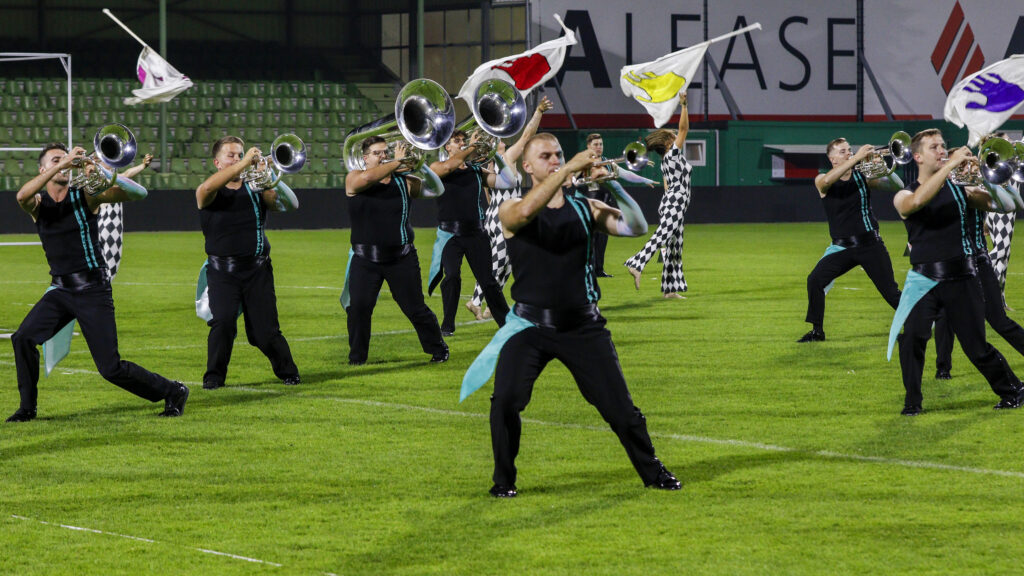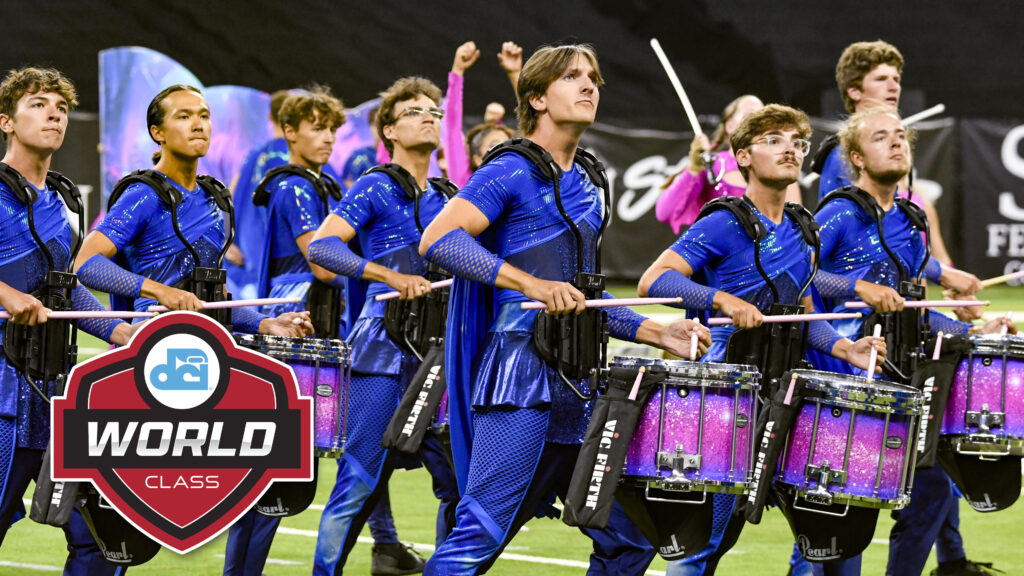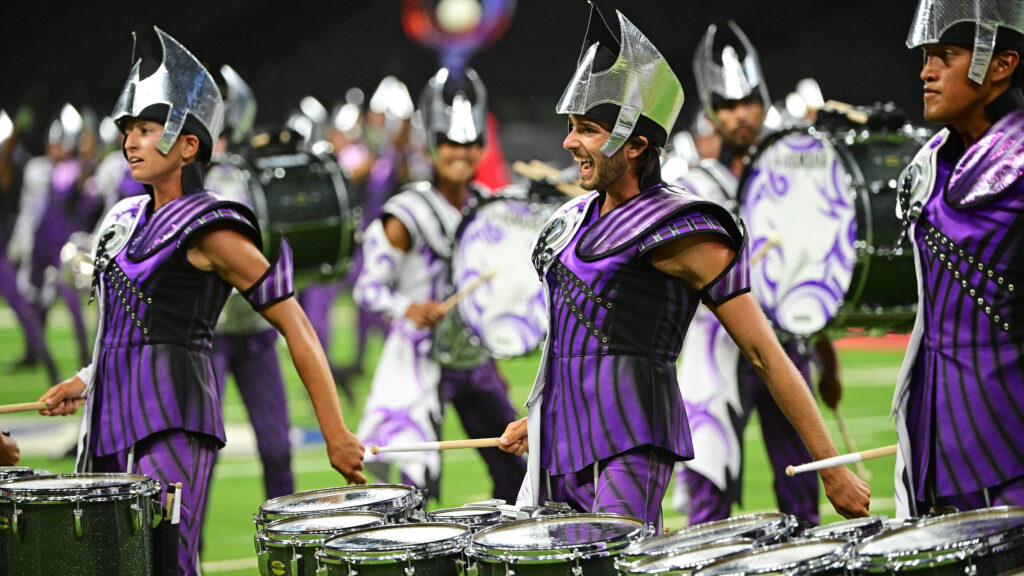Ask drum corps members what they remember about the 2006 Drum Corps International Tour, and there’s a good chance they’ll mention the long and oppressive Midwest heat wave, an unpleasant visitor to the middle of the season that forced corps to spend several unplanned hours rehearsing indoors.
That weather anomaly was followed by the cancellation of the top-8 corps show in Murfreesboro due to violent storms, a weekend that was saved by all the corps heading indoors the next day at the first-ever DCI Southeastern Championship in Atlanta.
The season culminated at the University of Wisconsin’s Camp Randall Stadium, substantially modernized and enlarged since any of the DCI World Championships’ previous six visits to the popular drum corps icon. For the seventh visit to the venue, the Cavaliers picked up the corps’ seventh DCI title with “Machine.”
Placing eighth was Carolina Crown with its show, “in.trance.it.” The title referenced the experience of being deep in thought or in a trance. It also gave a nod to the experience of traveling, being somewhere now and somewhere else later, with movement presenting a sense of how we get from one place or time to the next. The staff referred to this concept as “motion/movement,” pointing out that the music itself provided the concept of movement, traveling forward either by different forms of transportation or just referencing moving through life.
Two selections by American composer Richard Danielpour filled the entire show. Danielpour, like many post-World War II composers, started out writing intellectually obtuse and abstract music, but was gradually won over by melody and a desire to make his music more approachable to the public. Among American composers, the strength and accessibility of his music is often compared to Copland, Bernstein, and Barber. He has commented that music must have “an immediate visceral impact and elicit a visceral response,” adding, “There must be a moment of the ‘aha!’—of discovering something beyond one’s own immediate environment or experience in order to grow.”
There were quite a number of “aha” moments in Crown’s show, instances when the audience connected with the non-threatening contemporary music that was at once new and yet familiar. Most of the music was from the first three of five movements of “Urban Dances,” conceived by the composer as a 24-hour cycle, beginning at high noon in New York and moving into the wee hours of the morning. A brief statement from Danielpour’s “Celestial Night” was also heard in the show. Both works were composed in 1996.

Prior to the start of the music, the corps members, positioned within a series of concentric circle swirls, froze in position as if they were photographed during a brisk walk, arms appearing to sway and legs in a forward lunge. Everyone on the field looked as if they had a place they had to be and little time to spare to get there. The swirls started to unwind to the frenetic repetitive music in the front ensemble, and soon, the brass players unleashed the power they had just started to become known for as they gathered in a formation of the corps’ signature crown.
There was a series of brass highs and lows throughout the piece, the music ebbing and flowing like a roller coaster hugging the rails, but in continuous danger of flying off into the unknown. During the drum break, the horn members, in various parallel lines, started walking off in opposing directions. The visual effect was as if they were on city sidewalks on both sides of a street, quickly heading to work and following one another like a bunch of ants on a mission at a picnic.
The second movement featured a few rock-out segments that allowed the color guard to make some quirky movements, presenting a sense of unruffled indifference in the middle of the workday, the kind of body language one might see around a water cooler. A larger color guard feature presented the ensemble up front during an extended reflective ballad, offering a series of duet pas-de-deux montages. The climactic full-guard section dance, sans equipment, was always a moment that elicited a strong audience reaction that audibly soared above the quiet expressions of the music.

The third movement saw the horns create a block formation of the crown, accompanied by music that relentlessly chugged along with a rhythmic direction of getting somewhere fast. All horns then turned to the upper left corner of the field and headed into a series of sunray forms, the dawn of the new day at the end of the 24-hour cycle that Danielpour had conceived in writing “Urban Dances.”
Standing still within the rays, the brass players created a waterfall effect akin to a Doppler wave of a passing train whistle, the pitch dipping as the members turned from one direction to another. It was a serenely satisfying moment that balanced all the previous bombast.
The horns had one last little moment that sealed the completion of the 24-hour cycle. At the very end of the show with the sun shining as bright orange flags upon the new day, the horns ever so gently lifted themselves on their tiptoes to accent the brief rise of two short notes just seconds from the end of the show. It was one of those little moments that the corps would go on to seize with regularity as it continued to ascend through the ranks of DCI corps.
Related Content

Michael Boo was a member of the Cavaliers from 1975-1977. He wrote about the drum corps activity for more than 35 years while serving as a staff writer for various Drum Corps International projects. During his lifetime Boo wrote for numerous other publications including an honors-winning book on the history of figure skating. He also was an accomplished composer. Boo passed away in 2020 and was inducted into the DCI Hall of Fame posthumously in 2021.





